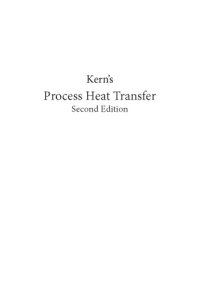
Ebook: Kern's process heat transfer
Author: Akashige Toshihiro, Flynn Ann Marie, Theodore Louis
- Tags: Technology., TECHNOLOGY & ENGINEERING -- General.
- Year: 2019
- Publisher: Wiley
- City: Hoboken, NJ
- Edition: 2
- Language: English
- pdf
This book insures the legacy of the original 1950 classic, Process Heat Transfer, by Donald Q. Kern. This second edition book is divided into three parts: Fundamental Principles; Heat Exchangers; and Other Heat Transfer Equipment/ Considerations. - Part I provides a series of chapters concerned with introductory topics that are required when solving heat transfer problems. This part of the book deals with topics Read more...
Abstract: This book insures the legacy of the original 1950 classic, Process Heat Transfer, by Donald Q. Kern. This second edition book is divided into three parts: Fundamental Principles; Heat Exchangers; and Other Heat Transfer Equipment/ Considerations. - Part I provides a series of chapters concerned with introductory topics that are required when solving heat transfer problems. This part of the book deals with topics such as steady-state heat conduction, unsteady-state conduction, forced convection, free convection, and radiation. - Part II is considered by the authors to be the "meat" of the book - addressing heat transfer equipment design procedures and applications. In addition to providing a more meaningful treatment of the various types of heat exchangers, this part also examines the impact of entropy calculations on exchanger design. - Part III of the book examines other related topics of interest, including boiling and condensation, refrigeration and cryogenics, boilers, cooling towers and quenchers, batch and unsteady-state processes, health & safety and the accompanying topic of risk. An Appendix is also included. What is new in the 2nd edition Changes that are addressed in the 2nd edition so that Kern's original work continues to remain relevant in 21st century process engineering include:- Updated Heat Exchanger Design- Increased Number of Illustrative Examples- Energy Conservation/ Entropy Considerations- Environmental Considerations- Health & Safety- Risk Assessment- Refrigeration and Cryogenics- Inclusion of SI Units